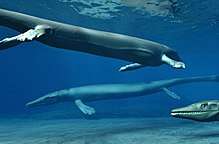Kristianstad Basin
The Kristianstad Basin (Swedish: Kristianstadsbassängen)[1] is a Cretaceous-age structural basin and geological formation in northeastern Skåne, the southernmost province of Sweden. The basin extends from Hanöbukten, a bay in the Baltic Sea, in the east to the town of Hässleholm in the west and ends with the two horsts Linderödsåsen and Nävlingeåsen in the south. The basin's northern boundary is more diffuse and there are several outlying portions of Cretaceous-age sediments. During the Cretaceous, the region was a shallow subtropical to temperate inland sea and archipelago.
| Kristianstad Basin Stratigraphic range: Late Cretaceous, Santonian – Early Maastrichtian, 87–71.3 Ma | |
|---|---|
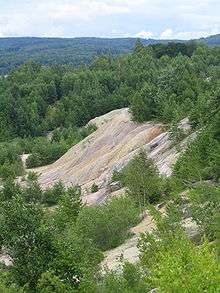 Kaolinbrottet, one of the quarries at Ivö Klack in the Kristianstad Basin | |
| Type | Structural basin, geological formation |
| Thickness | c. 250 m (820 ft) |
| Lithology | |
| Primary | Calcarenite, sandstone |
| Other | Conglomerates, flint, oyster banks, sand |
| Location | |
| Region | North-eastern Skåne |
| Country | |
| Type section | |
| Named for | Kristianstad, Kristianstad Municipality, Skåne County |
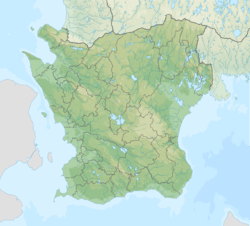 Kristianstad Basin (Skåne) | |
Though the sediments in the basin range in age from the Barremian to the earliest Maastrichtian, the only accessible strata are from the Late Cretaceous, ranging in age from the Early or early Middle Santonian to the earliest Maastrichtian. A majority of the fossil sites only expose strata of latest Early Campanian age (c. 80 million years ago). Fossils from these sites have been collected since the 18th century, but most of the excavations have taken place through commercial quarrying in the 20th century and paleontological expeditions in the 20th and 21st centuries.
The Early Campanian deposits of the Kristianstad Basin preserve fossils of a diverse array of organisms, including algae, brachiopods, bryozoans, molluscs (notably large numbers of bivalves and belemnites), sea urchins, fish (including a large amount of shark species). The Kristianstad Basin has also yielded fossils of several varieties of reptiles, including plesiosaurs, turtles and crocodylomorphs, as well as one of the most diverse mosasaur faunas in the world and the only non-avian dinosaurs known from Sweden.
Geology
Geological background

The Kristianstad Basin is located in northeastern Skåne, the southernmost province of Sweden, extending from Hanöbukten, a bay in the Baltic Sea, in the east to the town of Hässleholm in the west.[2] The basement of the basin is crystalline and deeply weathered bedrock from the Precambrian.[3] Most of this weathering, and the uneven topography of the basement, is due to the warm and moist climate experienced during the Jurassic or Early Cretaceous.[2] The basement is overlaid by approximately 250 metres (820 feet) of mainly shallow water or marine sediments from the Cretaceous, ranging in age from the Barremian to the earliest Maastrichtian.[3] In addition to the aquatic sediments, there are delta plain deposits of late Santonian to earliest Campanian age, overlaid by marine strata of latest Early Campanian age.[4]
The surface of the basement slopes to the south and is cut off by Linderödsåsen and Nävlingeåsen, two horsts that mark the basin's south-western boundary. To the south-east, the basin's margin is marked by the Baltic Sea while the basin's northern margin is more diffuse, with several small outliers of Cretaceous-age sediments.[4]
During the Late Cretaceous, the basement of the basin was subjected to several regressions and transgressions.[5] The sediments within the basin are dominated by fine- to coarse-grained sandy biocalcarenites (calcarenites that contain fossils) and more or less consolidated sandstones. Conglomeratic beds are also common, typically consisting of belemnite rostra or bivalve shells and coarse terrigenous clastic rocks. There are also several flint beds in the upper parts of the strata, dating to the early Late Campanian through the earliest Maastrichtian.[6] Dominant sediment types from the Early Campanian are oyster banks, calcarenites and calcareous, glauconitic quartz sands.[4]
Accessible strata exposed in the basin range in age from Early or early Middle Santonian to earliest Maastrichtian.[4] A majority of the fossil sites only expose strata of latest Early Campanian age[6] (c. 80 million years ago).[7] With the sole exception of the Ugnsmunnarna site,[8] which is the only large natural outcrop of Late Cretaceous strata in Sweden, the sites within the Kristianstad Basin are the result of commercial kaolin clay/limestone exploitation.[6]
The biozones of the Kristianstad Basin, based on belemnite fossils, are:
- Early to Middle Santonian: Gonioteuthis westfalica westfalica.[9]
- Late Middle Santonian: Gonioteuthis westfalicagranulata.[9]
- Late Santonian: Gonioteuthis granulata.[9]
- Earliest Campanian: Gonioteuthis granulaquadrata,[10] alongside Actinocamax verus, Belemnellocamax grossouvrei[4] and Belemnitella alpha.[9]
- Latest Early Campanian: Belemnellocamax mammillatus,[10] alongside Belemnitella mucronata and Gonioteuthis quadrata scaniensis.[4] This zone is exceptionally rich in vertebrate fossils and diversity.[11]
- Earliest Late Campanian: Belemnellocamax balsvikensis.[12]
- Early Late Campanian: Belemnitella mucronata.[13]
- Middle Late Campanian: also Belemnitella mucronata.[14]
- Late Late Campanian or earliest Maastrichtian: Belemnella lanceolata.[13]
Prominent fossil sites
| Map of prominent fossil sites within the Kristianstad Basin |
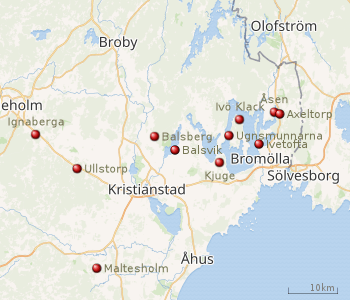 |
- Ivö Klack, historically known as Blaksudden, an abandoned and partly overgrown limestone and kaolin quarry on the northern slope of the island Ivö.[15] Ivö Klack was once the shores of a small and rocky Cretaceous island and is one of the most extensively excavated sites in the basin, having been excavated since quarrying activities started in 1888. Though quarrying stopped in the late 1960s, the site continues to be excavated by paleontologists and amateurs.[16]
- Ugnsmunnarna, a partly overgrown cliff section located on the island Ivö, about three kilometers south of Ivö Klack. The rocks at Ugnsmunnarna were deposited in a deeper-water part surrounding the Cretaceous Ivö island.[16]
- Ignaberga, the Ignaberga site compromises two limestone quarries situated along the southern margin of the basin created by Nävlingeåsen.[16]
- Maltesholm, a now disused limestone quarry adjacent to the northern end of Linderödsåsen. With the exception of abundant fragmentary invertebrate fossils, few other fossil remains have been found at Maltesholm.[16]
- Åsen, an abandoned clay pit, presently used as a landfill. The topography of the basement rock, the presence of floodplain sediments and the recovery of fossil hybodont shark teeth suggests that the localion was near an ancient river system. One of the most extensively excavated sites in the basin.[16]
- Axeltorp, an abandoned and overgrown limestone quarry.[16]
- Balsberg, a natural cave located on the southwestern slope of the Balsberget hill.[16]
- Ivetofta, a drill core in the town of Bromölla, the sediments penetrated are of latest Early Campanian age.[16]
- Kjuge, a natural cliff section located near the lake Ivösjön.[16]
- Ullstorp, a series of five small quarries (one of which remains active) close to Nävlingeåsen.[17]
- Balsvik, an overgrown quarry which in addition to Campanian rocks also exposes approximately three meters (9 ft) of earliest Maastrichtian strata.[18]
History of study
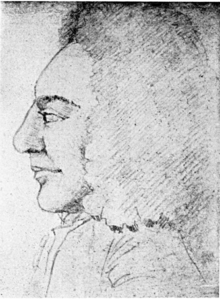
The Kristianstad Basin is one of the most prolific and historically famous Mesozoic fossil sites in Scandinavia. The earliest known fossil discoveries within the basin were made by the physician and paleontologist Magnus Bromelius at Ivö Klack and Ignaberga in 1725. Most of the early fossil finds were belemnite fossils, descriptions of which were published by physician and naturalist Kilian Stobæus in 1752 (whose work Opuscula included the first illustrations of the common Belemnellocamax mammillatus belemnites), naturalist Göran Wahlenberg in 1821 and zoologist and archaeologist Sven Nilsson in 1826, 1827, 1835 and 1857. Early sedimentological studies were also conducted throughout the 19th and early 20th centuries, prominently by paleontologist and geologist Bernhard Lundgren in 1888 and geologist Alf Lundegren in 1931 and 1934.[19]
The various limestone and kaolin quarries throughout the basin were described in detail by geologist and paleontologist Karl A. Grönwall in 1915, followed by further descriptions by Alf Lundegren in 1931, geologist Lars Bjerning in 1947, geologist Per H. Lundegårdh in 1971, geologists Jan Bergström and Naz Ahmed Shaikh in 1980 and geologists Mikael Erlström and Jan Gabrielson in 1985 and 1992. Throughout the 20th century, quarrying was most intense at Åsen, Axeltorp and Ivö Klack, most of it conducted by the companies Höganäs keramik and Ifö-verken.[20]
Important historical studies conducted on the basin's many invertebrate taxa include those by Bernhard Lundgren (in 1876, 1885 and 1895), paleontologist J. Christian Moberg in 1884 and 1885, geologist Anders H. Hennig in 1892, 1894 and 1904 (together with paleontologist Alfred Elis Törnebohm), geologist and mineralogist Assar Hadding in 1919, Bernhard Lundegren in 1934, paleontologist Gustaf Troedsson in 1946 and 1954, paleontologist Richard Hägg in 1954 and geologist and paleontologist Fritz Brotzen in 1960. Further studies on the invertebrate fauna, as with the more publicized vertebrate fossils, have continued into the 21st century.[20]
Actinopterygian (ray-finned) fishes were first described form the basin by Sven Nilsson in 1827, with further studies being conducted by paleontologist John W. Davis in 1890 and by paleontologist Mohamad Bazzi and colleagues in 2016. Though shark teeth have been recovered from the basin since early times, the shark and ray fauna was first studied in detail by paleontologist Mikael Siverson in the 20th century, who in a series of publications from 1989 to 2016, some together with other authors, identified a vast number of species.[20]
Marine reptile fossils, found at Ivetofta, were first described from the basin by Sven Nilsson in 1835. Nilsson's work was followed by further investigations by physicist and chemist Wilhelm Hisinger in 1837, archaeologist and bibliographer Johan Henrik Schröder in 1885 and paleontologist Carl Wiman in 1916. Later studies on marine reptile fossils were also conducted by J. Christian Moberg in 1884 and 1885, Bernhard Lundgren in 1888, Anders H. Hennig in 1910, Alf Lundegren in 1934, Gustaf Troedsson in 1946 and 1954 and prominently in a series of publications of paleontologist Per-Ove Persson, who described several species of mosasaurs and plesiosaurs alongside sea turtles and the crocodylomorph Aigialosuchus, from 1954 to 1996. More recent work on marine reptiles has been conducted primarily by Mikael Siverson and paleontologist Johan Lindgren (especially on mosasaurs) and paleontologists Elisabeth Einarsson, Benjamin P. Kear, Sven Sachs and Torsten M. Scheyer (especially on plesiosaurs and sea turtles). Recent dinosaur discoveries, including both non-avian dinosaurs and hesperornithiform birds, have mainly been researched by Johan Lindgren and paleontologist Jan Rees alongside several colleagues.[20]
Depositional environment and paleoecology

During the transgressions experienced during the Late Cretaceous, the inland sea within the Kristianstad Basin remained very shallow, and its northern parts formed an archipelago with several low islands and a number of small peninsulas.[2] The climate was subtropical to temperate and local plant life included low-growing flowering plants, ferns, conifers and deciduous trees.[19]
Most of the area preserved in the Kristianstad Basin was a shallow marine inner shelf environment, as indicated by the present invertebrate fauna (which has been compared to modern faunas).[21] Most of the water was probably less than 40 meters (131 ft) deep,[2] but there were a wide range of environments present. These environments included rocky and sandy beach areas, drowned river valleys and neritic and deeper offshore environments.[19] There were shallow and protected coastal bays as well as coastal waters that were significantly deeper.[22]
Some structures within the rocks of the Basin, combined with the often fragmented and broken condition of the fossils recovered, indicates that the Cretaceous environment was a high-energy environment (one in which the water is fast-moving and agitated, created by waves and currents).[21]
During the Late Cretaceous, the Kristianstad region was home to a diverse marine fauna. The composition of the local fauna was characteristic of shallow marine life of an inner shelf community and included abundant algae, brachiopods, bryozoans, molluscs (including bivalves, gastropods, belemnites and the ammonites Baculites and Hauericeras), sea urchins, serpulids, decapods (such as Protocallianassa) and sponges.[23][24] Additionally, fish (including a vast array of sharks) were also common and fossils of many species of reptiles, most of them marine, have also been found, including mosasaurs, plesiosaurs, sea turtles, crocodylmorphs and a few dinosaurs.[22]
Shorelines of Ivö Klack
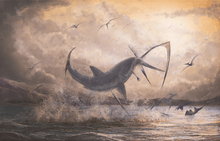
Ivö Klack was a small island during the Campanian.[25] Teeth from large lamniform sharks, such as Cretoxyrhina mantelli and Cretalamna appendiculata, are significantly more common at Ivö Klack than they are in other sites, such as Ignaberga. The prominence of large sharks in the area probably derives from large sharks requiring large prey, and large marine reptiles being common at Ivö Klack as well. There are plesiosaur fossils from Ivö Klack with shark bite marks. Modern great white sharks are known to patrol around small islands inhabited by seals, possibly a behavior also present in the similar Cretoxyrhina.[25] Ivö Klack is the only site where fossils of hesperornithiforms, a group of aquatic birds, are present.[26]
Fossil remains of large marine reptiles are also especially common at Ivö Klack.[25] The high diversity of sharks and mosasaurs recovered at Ivö Klack shows that large predators frequented the rocky coastline. There must have been a productive ecosystem, with a diverse invertebrate fauna attracting small nektonic predators (such as cephalopods and fish), which then in turn attracted larger predators. It is probable that the richness of the environment also made Ivö Klack a nursery and feeding ground for migratory species, similar to rocky shores today. The discovery of the basin's only crocodylomorph at Ivö Klack might indicate that Aigialosuchus preferred to live in coastal waters, where it could lay its egg on adjacent land, rest and heat up, similar to modern crocodilians.[27]
Murky waters of Åsen
The Åsen site is believed to have been a murky river mouth during the Campanian.[22] Teeth and vertebrae of small-sized (probably juvenile) Clidastes propython mosasaurs have been found at Åsen, which suggests that the area offered some protection against predation by larger mosasaurs and other predators,[28] possibly due to the murky waters produced by some nearby river system. This murky setting also seems to have been preferred by the many species of benthic sharks and rays recovered at Åsen.[27] Particularly, Rays significantly more common at Åsen than elsewhere. It is probable that they preferred the murky and estuarine environment there, similar to the environments preferred by their modern relatives.[22][28] The sharks and rays at Åsen probably fed on fish and invertebrates, which occur with less diversity (though still large numbers) at Åsen than elsewhere.[27] They might have primarily fed on soft-bodied invertebrates, less likely to be preserved in the fossil record.[29]
Terrestrial life
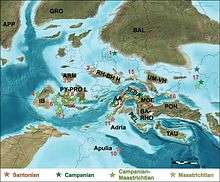
The few fragmentary dinosaur fossils recovered in the Kristianstad Basin represent the remains of specimens transported out into the sea during floods or storms. Despite being fragmentary, they add to our understanding of the as of yet poorly known dinosaur fauna of the Baltic Shield, which was an isolated landmass during the Late Cretaceous. It is also possible that the recovered dinosaurs were not from the landmass itself, but from the rocky islands of the adjacent archipelago in the Kristianstad Basin itself.[19][30] Dinosaur fossils recovered from the Kristianstad Basin can be confidently attributed to theropod, ornithopod and leptoceratopsid dinosaurs.[31]
The recovered dinosaurs all represent animals with lengths less than three meters (9 ft), but this does not necessarily mean that larger dinosaurs were absent; it is equally likely that only small animals were transported out into the sea where they could be fossilized and preserved. When large dinosaurs are excluded, the dinosaur fauna preserved in the Kristianstad Basin resembles that of Campanian–Maastrichtian dinosaur-bearing formations in Canada, which also include small ornithopods (such as Parksosaurus) and leptoceratopsids (such as Unescoceratops).[30]
Fossil wood has been recovered from late Middle Santonian to earliest Campanian-age deposits at Åsen, representing the tree genera Pinus, Platanus, Scandianthus, Silvianthemum and Actinocalyx.[32]
Vertebrate fossil content
Fish
Sharks
A majority of the sharks in the Kristianstad Basin were lamniforms and they were either nectonic (swimming freely in the body of water) or nectobenthic (active just above the sea floor).[22] The lamniform shark fauna in the basin represents the most diverse Late Cretaceous lamniform fauna yet discovered.[33] The most common genus of shark found is Carcharias.[22] All shark species found in the Kristianstad Basin were active predators, but many of them only fed on smaller food items such as bony fish and various invertebrates.[16] Large nektonic species, such as Squalicorax kaupi and Cretoxyrhina mantelli, presumably occupied the top of the food web. Bite marks from sharks are relatively common on reptile bones in the Kristianstad Basin.[28]
| Sharks reported from the Kristianstad Basin | |||||||
|---|---|---|---|---|---|---|---|
| Genus | Species | Sites | Age | Material | Notes | Images | Ref |
| Acanthoscyllium | A. sp. | Balsvik, Bjärlången, Ballingslöv | Late Campanian | Isolated teeth | A hemiscylliid shark | [34] | |
| Anomotodon | A. hermani | Ivö Klack, Ugnsmunnarna, Ignaberga, Åsen, Balsvik | Latest Early Campanian – early Late Campanian | Isolated teeth | A mitsukurinid shark | [35][36] | |
| Archaeolamna | A. kopingensis | Ivö Klack, Ugnsmunnarna, Ignaberga, Åsen, Ballingslöv, Balsvik | Latest Early Campanian – earliest Maastrichtian | Isolated teeth | A lamniform shark | [35][37][34] | |
| Carcharias | C. aasenensis | Ugnsmunnarna, Ignaberga, Åsen | Latest Early Campanian | Isolated teeth | An odontaspidid lamniform shark, same genus as the modern sand tiger shark | [35] | |
| C. latus | Ivö Klack, Ugnsmunnarna, Ignaberga, Maltesholm, Åsen | Latest Early Campanian | Isolated teeth | An odontaspidid lamniform shark, same genus as the modern sand tiger shark | [35] | ||
| C. tenuis | Ivö Klack, Ugnsmunnarna, Ignaberga, Åsen | Latest Early Campanian | Isolated teeth | An odontaspidid lamniform shark, same genus as the modern sand tiger shark | [35] | ||
| C. sp. | Balsvik, Bjärlången, Ballingslöv | Late Campanian | Isolated teeth | An odontaspidid lamniform shark, same genus as the modern sand tiger shark | [38] | ||
| Cederstroemia | C. nilsi | Åsen | Latest Early Campanian | Isolated teeth | A wobbegong shark | [35] | |
| C. sp. | Ullstorp | Earliest Campanian | Isolated teeth | A wobbegong shark | [32] | ||
| Centroscymnus | C. schmidi | Balsvik | Late Campanian/Earliest Maastrichtian | A single tooth from the lower jaw | Centroscymnus in the Kristianstad Basin are from a younger (Maastrichtian) layer than the other sharks. The genus survives to the present day. | [34][39] | |
| Chiloscyllium | C. gaemersi | Ugnsmunnarna, Balsvik, Ballingslöv | Latest Early Campanian – Late Campanian | Isolated teeth | A hemiscylliid shark, the genus survives to the present day | [35][34] | |
| C. sp. | Ivö Klack, Ugnsmunnarna, Ignaberga, Maltesholm, Åsen | Latest Early Campanian | Isolated teeth | A hemiscylliid shark, the genus survives to the present day | [35] | ||
| Cretalamna | C. appendiculata | Ivö Klack, Ugnsmunnarna, Ignaberga, Maltesholm, Åsen | Latest Early Campanian | Isolated teeth | An otodontid lamniform shark | [35] | |
| C. borealis | Ugnsmunnarna, Ignaberga, Ivö Klack, Åsen, Hanaskog | Latest Early Campanian – early Late Campanian | Isolated teeth | An otodontid lamniform shark | [40] | ||
| C. sacroportheta | Ugnsmunnarna, Ignaberga, Ivö Klack, Åsen, Maltesholm | Latest Early Campanian | Isolated teeth | An otodontid lamniform shark | [41] | ||
| Cretodus | C. borodini | Ignaberga, Åsen | Latest Early Campanian | Isolated teeth | A cretoxyrhinid lamniform shark | [35] | |
| Cretorectolobus | C. sp. | Ignaberga, Åsen | Latest Early Campanian | Isolated teeth | A carpet shark | [35] | |
| Cretoxyrhina | C. mantelli | Ivö Klack, Ignaberga, Ullstorp, Balsvik | Earliest Campanian – early Late Campanian | Isolated teeth | A large cretoxyrhinid lamniform shark | .jpg) |
[42][35] |
| Eoetmopterus | E. supracretaceus | Balsvik | Late Campanian | Isolated teeth | A squaliform shark | [34] | |
| Galeorhinus | G. sp. | Ivö Klack, Ugnsmunnarna, Ignaberga | Latest Early Campanian | Isolated teeth | A triakid shark, same genus as the modern school shark | [35] | |
| Hemiscylliidae sp. | – | Ignaberga | Latest Early Campanian | Isolated teeth | A hemiscylliid shark | [35] | |
| Hemiscyllium | H. hermani | Ugnsmunnarna, Ignaberga, Åsen, Balsvik, Ballingslöv | Latest Early Campanian – Late Campanian | Isolated teeth | A hemiscylliid shark, the genus survives to the present day | [35][34] | |
| Heterodontus | H. aff. rugosus | Ignaberga, Maltesholm, Balsvik | Latest Early Campanian – early Late Campanian | Isolated teeth | A heterodontiform shark, same genus as the modern bullhead shark | [43] | |
| H. sp. 1 | Ivö Klack, Ugnsmunnarna, Ignaberga, Maltesholm, Åsen | Latest Early Campanian | Isolated teeth | A heterodontiform shark, same genus as the modern bullhead shark | [35] | ||
| H. sp. 2 | Ivö Klack, Ignaberga, Åsen | Latest Early Campanian | Isolated teeth | A heterodontiform shark, same genus as the modern bullhead shark | [35] | ||
| Hybodus | H. sp. | Ivö Klack, Ignaberga, Åsen | Latest Early Campanian | A fragmentary fin spine and isolated teeth | A hybodontiform shark | 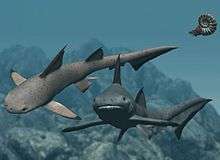 |
[35][44] |
| Meristodon | M. sp. | Ullstorp | Earliest Campanian | Isolated teeth | A hybodontiform shark | [32] | |
| Palaeogaleus | P. sp. | Ugnsmunnarna, Åsen | Latest Early Campanian | Isolated teeth | A triakid shark | [35] | |
| Paranomotodon | P. sp. | Ivö Klack, Ugnsmunnarna, Ignaberga, Åsen | Latest Early Campanian | Isolated teeth | A lamniform shark | [35] | |
| Paraorthacodus | P. andersoni | Ivö Klack, Ignaberga, Åsen, Balsvik | Latest Early Campanian – early Late Campanian | Four isolated teeth | A paleospinacid shark | [35][45][36] | |
| P. conicus | Ivö Klack, Ugnsmunnarna, Ignaberga, Åsen, Balsvik | Latest Early Campanian – early Late Campanian | Over a thousand isolated teeth | A paleospinacid shark | [35][46][36] | ||
| P. n. sp. | Balsvik | Early Late Campanian | Isolated teeth | A paleospinacid shark | [36] | ||
| Pararhincodon | P. spp. | Ugnsmunnarna, Ignaberga, Maltesholm, Åsen, Balsvik, Bjärlången, Ballingslöv | Latest Early Campanian – Late Campanian | Isolated teeth | A parascylliid shark, probably several species | [35][34] | |
| Parasquatina | P. sp. | Balsvik | Late Campanian | Isolated teeth | A synechodontiform shark | [34] | |
| Paratriakis | P. sp. | Ivö Klack, Ugnsmunnarna, Ignaberga, Maltesholm, Åsen, Ballingslöv | Latest Early Campanian – Late Campanian | Isolated teeth | A triakid shark | [35][34] | |
| Polyacrodus | P. siversoni | Åsen | Latest Early Campanian | Isolated teeth | A hybodontiform shark | [35] | |
| P. sp. | Åsen, Ullstorp | Earliest Campanian – latest Early Campanian | Isolated teeth | A hybodontiform shark | [32][35] | ||
| Proetmopterus | P. hemmooriensis | Balsvik, Bjärlången, Ballingslöv | Late Campanian | Isolated teeth | A squaliform shark | [34] | |
| Pseudocorax | P. laevis | Ignaberga, Åsen, Balsvik | Latest Early Campanian – early Late Campanian | Isolated teeth | An anacoracid lamniform shark | [35][36] | |
| P. aff. affinis | Ballingslöv | Earliest Maastrichtian | A single isolated tooth | An anacoracid lamniform shark, in later (Maastrichtian) strata than the other sharks | [37] | ||
| Pseudoscapanorhynchus | P. sp. | Balsvik | Early Late Campanian | Isolated teeth | A mitsukurinid shark | [36] | |
| Ptychodus | P. spp. | Ignaberga | Late Middle Santonian – earliest Campanian | Isolated teeth | A hybodontiform shark, found in earlier strata than most other sharks |  |
[32] |
| Scapanorhynchus | S. perssoni | Ivö Klack, Ugnsmunnarna, Åsen | Latest Early Campanian | Isolated teeth | A mitsukurinid shark | 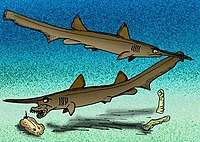 |
[35] |
| Scyliorhinidae sp. 1 | – | Åsen | Latest Early Campanian | Isolated teeth | A catshark | [35] | |
| Scyliorhinidae sp. 2 | – | Ivö Klack | Latest Early Campanian | Isolated teeth | A catshark | [35] | |
| Scyliorhinus | S. germanicus | Ivö Klack, Ugnsmunnarna, Ignaberga, Maltesholm, Åsen | Latest Early Campanian | Isolated teeth | A catshark, the genus survives to the present day | [35] | |
| S. moosi | Balsvik, Bjärslången, Ballingslöv | Late Campanian | Isolated teeth | A catshark, the genus survives to the present day | [38] | ||
| Serratolamna | S. sp. | Åsen | Latest Early Campanian | Isolated teeth | A cretoxyrhinid lamniform shark | [35] | |
| Squalicorax | S. kaupi | Ivö Klack, Ugnsmunnarna, Ignaberga, Maltesholm, Åsen | Latest Early Campanian | Isolated teeth | An anacoracid lamniform shark |  |
[35] |
| S. lindstromi | Ugnsmunnarna, Ignaberga, Ivö Klack, Åsen, Maltesholm, Hanaskog | Latest Early Campanian – early Late Campanian | Isolated teeth | An anacoracid lamniform shark | [40] | ||
| Squalidae spp. | – | Ivö Klack, Ugnsmunnarna, Ignaberga, Maltesholm, Åsen | Latest Early Campanian | Isolated teeth | A squalid shark, probably several species | [35] | |
| Squalus | S. ballingsloevensis | Ballingslöv, Bjärlången | Late Campanian – earliest Maastrichtian | More than a hundred isolated teeth | Squalus in the Kristianstad Basin are from a younger (Maastrichtian) layer than the other sharks. Same genus as modern spurdogs. The Ballingslöv site is not part of the Kristianstad Basin proper, representing a northwestern isolated outcrop. | [34][47][35] | |
| S. balsvikensis | Balsvik, Bjärlången, Ballingslöv | Late Campanian – earliest Maastrichtian | Several hundred isolated teeth | Squalus in the Kristianstad Basin are from a younger (Maastrichtian) layer than the other sharks. Same genus as modern spurdogs. | [34][47] | ||
| Squatina | S. fortemordeo | Åsen | Latest Early Campanian | Isolated teeth | An angelshark, the genus survives to the present day | [48] | |
| S. lundegreni | Åsen | Latest Early Campanian | Isolated teeth | An angelshark, the genus survives to the present day | [48] | ||
| S. sp. | Ullstorp, Maltesholm, Bjärlången, Ballingslöv | Earliest Campanian – Late Campanian | Isolated teeth | An angelshark, the genus survives to the present day | [49] | ||
| Squatirhina | S. sp. | Ivö Klack, Ugnsmunnarna, Ignaberga, Maltesholm, Åsen | Latest Early Campanian | Isolated teeth | A wobbegong shark | [35] | |
| Synechodus | S. lerichei | Ugnsmunnarna, Ignaberga | Latest Early Campanian | Isolated teeth | A paleospinacid shark | [50] | |
| S. filipi | Ugnsmunnarna, Ignaberga, Åsen | Latest Early Campanian | Isolated teeth | A paleospinacid shark | [41] | ||
| S. perssoni | Ugnsmunnarna, Ignaberga | Latest Early Campanian | Isolated teeth | A paleospinacid shark | [51] | ||
| S. sp. 1 | Ivö Klack, Ugnsmunnarna, Ignaberga, Åsen, Balsvik | Latest Early Campanian – Late Campanian | Isolated teeth | A paleospinacid shark | [35][34] | ||
| S. sp. 2 | Ivö Klack, Ugnsmunnarna, Ignaberga, Maltesholm, Åsen, Balsvik | Latest Early Campanian – Late Campanian | Isolated teeth | A paleospinacid shark | [35][34] | ||
Holocephali
| Holocephali reported from the Kristianstad Basin | |||||||
|---|---|---|---|---|---|---|---|
| Genus | Species | Sites | Age | Material | Notes | Images | Ref |
| Amylodon | A. sp. | Åsen | Latest Early Campanian | Dental remnants | A chimaeriform fish | [52] | |
| Edaphodon | E. sp. | Åsen | Latest Early Campanian | Dental remnants | A chimaeriform fish | [52] | |
| Elasmodus | E. sp. | Åsen, Hanaskog | Latest Early Campanian – early Late Campanian | Dental remnants and a mandibular plate | A chimaeriform fish | [53] | |
| Ischyodus | I. bifurcatus | Åsen | Latest Early Campanian | Dental remnants | A chimaeriform fish | [52] | |
Rays
| Rays reported from the Kristianstad Basin | |||||||
|---|---|---|---|---|---|---|---|
| Genus | Species | Sites | Age | Material | Notes | Images | Ref |
| Raja | R. sp. | Balsvik, Bjärlången, Ballingslöv | Earliest Maastrichtian | Isolated teeth | A rajiform ray. Raja in the Kristianstad Basin are from younger (Maastrichtian) strata than the other rays. The genus survives to the present day. | [37] | |
| Rhinobatidae sp. | – | Balsvik, Bjärlången, Ballingslöv | Earliest Maastrichtian | Isolated teeth | A rhinobatid ray, Maastrichtian Rhinobatid ray fossils outnumber those of Raja at Bjärlången and Ballingslöv but are less common at Balsvik. | [37] | |
| Rhinobatoidea sp. 1 | – | Ignaberga | Latest Early Campanian | Isolated teeth | A rhinobatoid ray | [35] | |
| Rhinobatoidea sp. 2 | – | Ugnsmunnarna, Åsen | Latest Early Campanian | Isolated teeth | A rhinobatoid ray | [35] | |
| Rhinobatos | R. casieri | Åsen | Latest Early Campanian | Isolated teeth | A rhinobatid ray, the genus survives to the present day | [35] | |
| R. sp. 1 | Åsen | Latest Early Campanian | Isolated teeth | A rhinobatid ray, the genus survives to the present day | [35] | ||
| R. sp. 2 | Åsen | Latest Early Campanian | Isolated teeth | A rhinobatid ray, the genus survives to the present day | [35] | ||
| R. sp. 3 | Ivö Klack, Ignaberga, Åsen | Latest Early Campanian | Isolated teeth | A rhinobatid ray, the genus survives to the present day | [35] | ||
| Sclerorhynchidae indet. | – | Ullstorp | Earliest Campanian | Isolated teeth | A sclerorhynchid ray, fossils as of yet unpublished | [32] | |
| Walteraja | W. exigua | Balsvik | Late Campanian | Isolated teeth | A rajiform ray | [34] | |
Ray-finned fish
| Actinopterygii reported from the Kristianstad Basin | |||||||
|---|---|---|---|---|---|---|---|
| Genus | Species | Sites | Age | Material | Notes | Images | Ref |
| Anomoeodus | A. subclavatus | Ivö Klack, Ignaberga, Åsen | Latest Early Campanian – early Late Campanian | Dentitions and isolated teeth | A pycnodontid fish | [54] | |
| A. sp. | Balsvik, Ullstorp | Latest Early Campanian – early Late Campanian | Two isolated teeth | A pycnodontid fish | [55] | ||
| Enchodus | E. cf. gladiolus | Site not reported | Uncertain | A single isolated palatine tooth | An aulopiform fish | 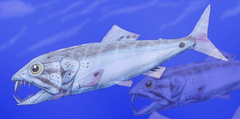 |
[56] |
| E. sp. | Åsen | Latest Early Campanian | Dental remnants | An aulopiform fish, Enchodus-like dental remnants are abundant at Åsen and show considerable morphological variety. | [57] | ||
| cf. E. sp. | Balsvik | Uncertain | A single isolated palatine tooth | An aulopiform fish, morphology of this tooth is distinct from the tooth attributed to E. gladiolus. | [57] | ||
| Ichthyodectidae indet. | – | Åsen | Latest Early Campanian – early Late Campanian | Two isolated teeth and a single isolated scale | An ichthyodectid fish, similar to Gillicus. | [58] | |
| Lepisosteidae indet. | – | Åsen | Latest Early Campanian | A single isolated scale | A gar | [59] | |
| Pachyrhizodus | cf. P. sp. | Åsen | Latest Early Campanian – early Late Campanian | Four isolated teeth | An elopiform fish | [56] | |
| Protosphyraena | P. sp. | Ivö Klack, Åsen, Ullstorp | Earliest Campanian – latest Early Campanian | Six isolated teeth | A pachycormid fish. The teeth of Protosphyraena are much larger than those of the other fish in the basin and were once mistakenly referred to theropod dinosaurs. | 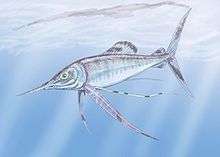 |
[32][55] |
| Pycnodontidae indet. | – | Åsen, Ullstorp | Latest Early Campanian | Two isolated teeth | A pycnodontid fish | [55] | |
| Teleostei indet. | – | Åsen | Latest Early Campanian | Two isolated teeth | A teleost fish, teeth similar to those attributed to Pachyrhizodus, but lack key diagnostic features. | [57] | |
Mosasaurs
The Swedish latest Early Campanian mosasaur fauna is one of the most taxon-rich assemblages of mosasaurs known, rivalled only by the Maastrichtian "Mosasaurus shales" fauna of southwestern Niger, the late Maastrichtian Maastricht Formation of the southern Netherlands, the early Maastrichtian Ciply Phosphatic Chalk fauna of southern Belgium and the contemporary Mooreville Chalk fauna of west-central Alabama.[60] The mosasaurs were large, carnivorous reptiles at the top of the food chain and since all the Campanian species are known from several sites, it is likely that all of them lived in the entire basin. The most common mosasaurs were the smaller-sized Clidastes and Eonatator. The high diversity of mosasaurs in the basin can be explained by the dissimilarity in dentition and body size between the species, meaning that they would not have competed with each other for food.[28]
| Mosasaurs reported from the Kristianstad Basin | |||||||
|---|---|---|---|---|---|---|---|
| Genus | Species | Sites | Age | Material | Notes | Images | Ref |
| Clidastes | C. propython | Ivö Klack, Ugnsmunnarna, Ignaberga, Åsen, Axeltorp | Latest Early Campanian – early Late Campanian | Isolated (probably shed) tooth crowns, vertebrae | Most of the Clidastes fossils in the Kristianstad Basin are probably from juveniles measuring about 2–3 meters in length, with a few adult invidivuals at probably around 6 meters. | 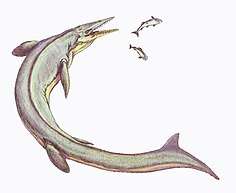 |
[35][61][62][36] |
| Dollosaurus | D. sp. | Ivö Klack, Åsen | Latest Early Campanian | Isolated teeth, fragments of a jawbone, vertebrae | A mosasaur at about 8 meters in length with relatively wide and deep jaws. Bite marks matching Dollosaurus teeth have been found on plesiosaur bones in the Kristianstad Basin. Dollosaurus is frequently treated as synonymous with Prognathodon. | 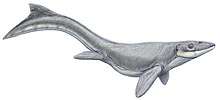 |
[35][61][63] |
| Eonatator | E. sternbergi | Ivö Klack, Ignaberga, Åsen | Latest Early Campanian – early Late Campanian | Isolated (probably shed) teeth, marginal tooth crowns, vertebrae, a premaxilla and a pterygoid | Eonatator teeth are relatively common in the Kristianstad Basin, indicating that there were a relatively large number of individuals present. | 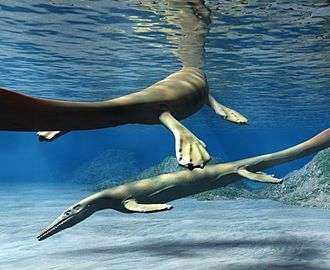 |
[35][64][36] |
| Hainosaurus | H. sp. | Ivö Klack, Ugnsmunnarna, Maltesholm, Åsen | Latest Early Campanian | Isolated marginal teeth | A large tylosaurine mosasaur. Hainosaurus is frequently treated as synonymous with Tylosaurus. | 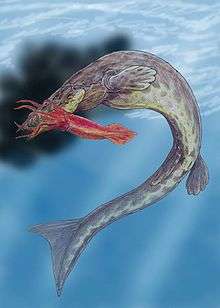 |
[35][64] |
| Mosasaurus | M. aff. lemonnieri | Åhus | Latest Campanian/earliest Maastrichtian | A single isolated tooth crown (probably shed) | Known from a single tooth, Mosasaurus in the Kristianstad Basin is from a younger (Late Campanian/Maastrichtian) layer than the other mosasaurs. Similar in body size (and likely ecological niche) to the earlier Tylosaurus ivoensis. |  |
[65][66] |
| Platecarpus | P. sp. | Ivö Klack, Åsen, Ullstorp | Earliest Campanian – latest Early Campanian | Several detached tooth crowns, fragments of a jawbone | Previously referred to Platecarpus somenensis. The material referred to Platecarpus might be non-diagnostic. |  |
[32][35][64][67] |
| Plioplatecarpus | P. cf. primaevus | Balsvik | Late Campanian/earliest Maastrichtian | A partial right quadrate | The overall morphology of the quadrate bone is consistent with Plioplatecarpus and in particular with P. primaevus, a species otherwise only found in North America. The quadrate is from a younger (Maastrichtian) layer than the other mosasaurs. | 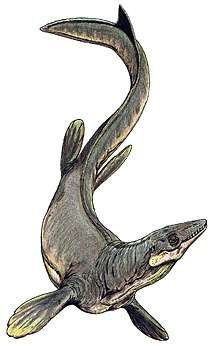 |
[34][68] |
| Tylosaurus | T. ivoensis | Ivö Klack, Ugnsmunnarna, Ignaberga, Åsen, Axeltorp, Balsberg | Latest Early Campanian – early Late Campanian | Several marginal teeth, pterygoid teeth, partial jawbones and several vertebrae | Previously referred to Mosasaurus and Hainosaurus. The largest mosasaur in the basin and "undoubtedly" its top predator, the lower jaw of Tylosaurus ivoensis is estimated to have been over 1.5 meters in length. |  |
[28][35][64][69][36] |
Plesiosaurs
The last comprehensive review of the plesiosaur fauna in the Kristianstad Basin was done by paleontologist Per-Ove Persson in the 1960s and his taxonomy is still used with caution, pending a much-needed new review. Because plesiosaurs are found in all the different environments thought to have existed in the Kristianstad Basin, they are believed to have been present in the entire basin.[27]
| Plesiosaurs reported from the Kristianstad Basin | |||||||
|---|---|---|---|---|---|---|---|
| Genus | Species | Sites | Age | Material | Notes | Images | Ref |
| Elasmosaurus? | E. cf. gigas | Ignaberga | Latest Early Campanian | A single vertebral centrum from the thoracic-lumbar region | A large elasmosaurid plesiosaur, the centrum is very poorly preserved |  |
[35][70] |
| E. cf. helmersenii | Ivö Klack | Latest Early Campanian | A single vertebral centrum from the cervical region | A large elasmosaurid plesiosaur, the centrum is very well preserved | [35][71] | ||
| Polycotylidae indet. | – | Ivö Klack | Latest Early Campanian | Four incomplete vertebrae | Poorly preserved fossils, might be the same taxon as the other polycotylid | [35][61][72] | |
| Polycotylidae? indet. | – | Ivö Klack | Latest Early Campanian | Twelve detached teeth | Poorly preserved fossils, might be the same taxon as the other polycotylid | [35][73] | |
| Scanisaurus | S. cf. nazarowi | Ivö Klack, Ignaberga, Maltesholm, Axeltorp, Kjuge | Latest Early Campanian | Vertebral centra, detached teeth, diaphysical ossifications of humeri and femora | The most common plesiosaur in the Kristianstad Basin. Scanisaurus is no longer considered a valid taxon, but the name continues to be used for practical purposes. S. nazarowi is the type species of Scanisaurus and was previously referred to Cimoliasaurus. | [35][74][75] | |
| S. sp. | Ignaberga, Åsen | Latest Early Campanian – early Late Campanian | A crushed skull, isolated teeth | Fossils of this species include the only plesiosaurian skull (albeit crushed) known from Sweden. The preserved teeth are similar to those referred to Scanisaurus cf. nazarowi. | [35][36][76] | ||
Turtles
Though only two taxa have been identified so far, turtle remains are abundant in the Kristianstad Basin.[27] In addition to the fossils described below, indeterminate turtle remains, including limb bones and carapace fragments, have also been recovered from Ivö Klack, Ugnsmunnarna, Ignaberga and Åsen.[35][77]
| Turtles reported from the Kristianstad Basin | |||||||
|---|---|---|---|---|---|---|---|
| Genus | Species | Sites | Age | Material | Notes | Images | Ref |
| Osteopygis | O?. sp. | Maltesholm | Latest Early Campanian | An incomplete carapace | A macrobaenid turtle | [35][78] | |
| Trionychidae indet. | – | Ivö Klack | Latest Early Campanian | Shell fragments | A softshell turtle | [35] | |
Crocodylomorphs
In addition to the remains referred to Aigialosuchus, detached and unidentified crocodylomorph scutes have also been discovered in Campanian-age deposits at Ivö Klack.[79]
| Crocodylomorphs reported from the Kristianstad Basin | |||||||
|---|---|---|---|---|---|---|---|
| Genus | Species | Sites | Age | Material | Notes | Images | Ref |
| Aigialosuchus | A. villandensis | Ivö Klack, Ullstorp | Earliest Campanian – latest Early Campanian | Anterior parts of the skull and partial mandible | A marine dyrosaurid crocodylomorph and the only crocodylomorph known from the Kristianstad Basin. Likely durophagous (eating hard-shelled organisms). Its skull was similar to that of modern gharials. | [32][80][81] | |
Pterosaurs
Possible pterosaur bone fragments have been recovered from earliest Campanian-age deposits at Ullstorp, though they remain unpublished.[32]
Dinosaurs
Non-avian dinosaurs
Fossils of non-avian dinosaurs are exceptionally rare in Scandinavia, and the Kristianstad Basin is the only location in Sweden where dinosaur fossils have been recovered. The only other certain traces of dinosaurs in Sweden are footprints of Late Triassic/Early Jurassic age in northwestern Skåne, made by theropods (Eubrontes giganteus and Kayentapus soltykovensis) and thyreophorans.[31] Though theropod teeth were reported from Ivö Klack by Per-Ove Persson in the 1950s, these have since been identified as fish teeth, probably from the genus Protosphyraena.[31] Fossil material conclusively identified as dinosaurian was recovered only relatively recently, with material referred to a leptoceratopsid being described in 2007[10] and further fragmentary fossils of other groups being recovered during excavations from 2010 to 2013.[31]
| Non-avian dinosaurs reported from the Kristianstad Basin | ||||||
|---|---|---|---|---|---|---|
| Group | Sites | Age | Material | Notes | Images | Ref |
| Leptoceratopsidae indet. | Åsen, Ullstorp | Earliest Campanian – latest Early Campanian | Four maxillary teeth, a dentary tooth, two caudal vertebrae, one right manual phalanx | Morphology of the teeth recovered corresponds roughly to Leptoceratops. Given that the teeth lack some of the ridges present in the teeth of Leptoceratops, and because of geographical distance, the Åsen leptoceratopsid is likely a new taxon. |  |
[82][83] |
| Ornithopoda indet. 1 | Åsen | Latest Early Campanian | A left pedal phalanx | A small ornithopod dinosaur. The recovered phalanx resembles the same bone in Thescelosaurus assiniboiensis. |  |
[84] |
| Ornithopoda indet. 2 | Åsen | Latest Early Campanian | A left pedal phalanx | A small ornithopod dinosaur. The recovered phalanx resembles the same bone in Hypsilophodon foxii. |  |
[85] |
| Theropoda indet. | Ugnsmunnarna | Latest Early Campanian | An incomplete right tibia | Identified as the remains of a small theropod dinosaur after comparisons with the same bone in the Australian genus Australovenator. The bone structure confidently identifies the fossil as that of a non-avian theropod dinosaur. | [86] | |
Birds
In addition to the fossils described below, indeterminate hesperornithiform remains have also been recovered from Åsen.[27]
| Birds reported from the Kristianstad Basin | |||||||
|---|---|---|---|---|---|---|---|
| Genus | Species | Sites | Age | Material | Notes | Images | Ref |
| Baptornis | B. sp. | Ivö Klack | Latest Early Campanian | A dorsal vertebra and a tarsometatarsus | A hesperornithiform bird, specimens previously referred to "Parascaniornis stensioi" | [87] | |
| Hesperornis | H. rossicus | Ivö Klack | Latest Early Campanian | Two tarsometatarsi | A hesperornithiform bird |  |
[88] |
| H. sp. | Ivö Klack | Latest Early Campanian | A dorsal vertebra | A hesperornithiform bird, the vertebra recovered is less slender than the one in H. rossicus | [89] | ||
See also
| Wikimedia Commons has media related to Kristianstad Basin. |
References
- Hajny 2014, p. 8.
- Lindgren 1998, p. 4.
- Lindgren et al. 2007, pp. 929–930.
- Lindgren et al. 2007, p. 930.
- Siverson 1989, p. 4.
- Siverson 1989, p. 5.
- Einarsson 2018, p. 150.
- Siverson 1989, p. 6.
- Siverson 1993b, p. 8.
- Lindgren et al. 2007, p. 929.
- Källsten 2015, p. 1.
- Poropat et al. 2015, p. 232.
- Lindgren 2004, p. 222.
- Lindgren 2004, p. 223.
- Sørensen, Surlyk & Lindgren 2013, p. 86.
- Sørensen, Surlyk & Lindgren 2013, p. 88.
- Bazzi, Einarsson & Kear 2015, p. 280.
- Siverson 1993, p. 4.
- Einarsson 2018, p. 17.
- Einarsson 2018, p. 18.
- Källsten 2015, p. 2.
- Hajny 2014, p. 7.
- Lindgren 1998, p. 5.
- Einarsson 2018, p. 27–30.
- Siverson 1989, p. 7.
- Rees & Lindgren 2005, p. 1321.
- Sørensen, Surlyk & Lindgren 2013, p. 90.
- Sørensen, Surlyk & Lindgren 2013, p. 89.
- Sørensen, Surlyk & Lindgren 2013, p. 91.
- Poropat et al. 2015, p. 237.
- Poropat et al. 2015, p. 231.
- Einarsson 2018, p. 28.
- Siverson 1993b, p. 6.
- Einarsson 2018, p. 34.
- Sørensen, Surlyk & Lindgren 2013, p. 87.
- Einarsson 2018, p. 33.
- Siverson 1993b, p. 12.
- Einarsson 2018, p. 34–35.
- Siverson 1993, p. 16.
- Einarsson 2018, p. 29–33.
- Einarsson 2018, p. 29–32.
- Einarsson 2018, p. 28, 33.
- Einarsson 2018, p. 30–33.
- Siverson 1993b, p. 9.
- Siverson 1989, p. 14.
- Siverson 1989, p. 16.
- Siverson 1993, p. 6.
- Siverson et al. 2015, p. 251.
- Einarsson 2018, p. 28–35.
- Siverson 1989, p. 13.
- Siverson 1989, p. 11.
- Einarsson 2018, p. 32.
- Einarsson 2018, p. 32–33.
- Bazzi, Einarsson & Kear 2015, p. 278, 280, 283.
- Bazzi, Einarsson & Kear 2015, p. 278, 280, 284.
- Bazzi, Einarsson & Kear 2015, p. 278, 280, 285.
- Bazzi, Einarsson & Kear 2015, p. 278, 280, 286.
- Bazzi, Einarsson & Kear 2015, p. 278, 280, 284, 285.
- Bazzi, Einarsson & Kear 2015, p. 278, 280, 281.
- Lindgren 2004, p. 221.
- Källsten 2015, p. 4.
- Lindgren 1998, p. 6.
- Einarsson 2018, p. 154.
- Källsten 2015, p. 5.
- Källsten 2015, p. 5, 11.
- Lindgren 2004, p. 223–224.
- Lindgren 1998, p. 11.
- Lindgren 2004, p. 226.
- Lindgren 1998, p. 15, 22.
- Persson 1959, p. 446.
- Persson 1959, p. 444.
- Persson 1959, p. 441.
- Persson 1959, p. 442.
- Källsten 2015, p. 3.
- Persson 1959, p. 447.
- Persson 1996, p. 112.
- Persson 1959, p. 438.
- Persson 1959, p. 435.
- Persson 1959, p. 473.
- Sørensen, Surlyk & Lindgren 2013, p. 87, 90.
- Källsten 2015, p. 3, 11.
- Lindgren et al. 2007, p. 932, 934.
- Poropat et al. 2015, p. 233.
- Poropat et al. 2015, pp. 233–234.
- Poropat et al. 2015, pp. 234–235.
- Poropat et al. 2015, pp. 235–236.
- Rees & Lindgren 2005, p. 1324.
- Rees & Lindgren 2005, p. 1322.
- Rees & Lindgren 2005, p. 1323.
Cited bibliography
- Bazzi, Mohamad; Einarsson, Elisabeth; Kear, Benjamin P. (2015). "Late Cretaceous (Campanian) actinopterygian fishes from the Kristianstad Basin of southern Sweden". Geological Society London Special Publications. 434: 277–292.
- Einarsson, Elisabeth (2018). "Palaeoenvironments, palaeoecology and palaeobiogeography of Late Cretaceous (Campanian) faunas from the Kristianstad Basin, southern Sweden, with applications for science education". Litholund theses.
- Hajny, Cassandra (2014). "Ett mystiskt ryggradsdjursfossil från Åsen och dess koppling till den skånska, krittida ryggradsdjursfaunan". Examensarbeten i geologi vid Lunds universitet (in Swedish).
- Källsten, Lena (2015). "Diversity and Ecology of a Middle Campanian (Late Cretaceous) Marine Reptile Assemblage from Skåne, Southern Sweden". Independent Project at the Department of Earth Sciences, Uppsala University.
- Lindgren, Johan (1998). "Early Campanian mosasaurs (Reptilia; Mosasauridae) from the Kristianstad Basin, southern Sweden". Dissertations in Geology at Lund University.
- Lindgren, Johan (2004). "Stratigraphical distribution of Campanian and Maastrichtian mosasaurs in Sweden – evidence of an intercontinental marine extinction event?". GFF. 126 (2): 221–229.
- Lindgren, Johan; Currie, Philip J.; Siverson, Mikael; Rees, Jan; Cedeström, Peter; Lindgren, Filip (2007). "The First Neoceratopsian Dinosaur Remains From Europe". Palaeontology. 50 (4): 929–937.
- Persson, Per-Ove (1959). "Reptiles from the Senonian (U. Cret.) of Scania (S. Sweden)" (PDF). Arkiv för Mineralogi och Geologi. 2 (35): 431–519.
- Persson, Per-Ove (1996). "A crushed reptile skull provisionally referred to Scanisaurus sp". GFF. 118: 111–112.
- Poropat, Stephen F.; Einarsson, Elizabeth; Lindgren, Johan; Bazzi, Mohamad; Lagerstam, Clarence; Kear, Benjamin P. (2015). "Late Cretaceous dinosaurian remains from the Kristianstad Basin of southern Sweden". Geological Society of London Special Publications. 434: 231–239.
- Rees, Jan; Lindgren, Johan (2005). "Aquatic birds from the Upper Cretaceous (Lower Campanian) of Sweden and the biology and distribution of hesperornithiforms". Palaeontology. 48 (6): 1321–1329.
- Siverson, Mikael (1989). "Palaeospinacid selachians from the Late Cretaceous of the Kristianstad Basin, Skåne, Sweden". Dissertations in Geology at Lund University.
- Siverson, Mikael (1993). "Maastrichtian squaloid sharks from southern Sweden". Palaeontology. 36 (1): 1–19.
- Siverson, Mikael (1993). "Late Cretaceous and Danian neoselachians from southern Sweden" (PDF). Lund Publications in Geology. 110.
- Siverson, Mikael; Cook, T. D.; Cederström, Peter; Ryan, H. E. (2015). "Early Campanian (Late Cretaceous) squatiniform and synechodontiform selachians from the Åsen locality, Kristianstad Basin, Sweden". Geological Society London Special Publications. 434: 251–275.
- Sørensen, Anne Mehlin; Surlyk, Finn; Lindgren, Johan (2013). "Food resources and habitat selection of a diverse vertebrate fauna from the upperlower Campanian of the Kristianstad Basin, southern Sweden". Cretaceous Research. 42: 85–92.

